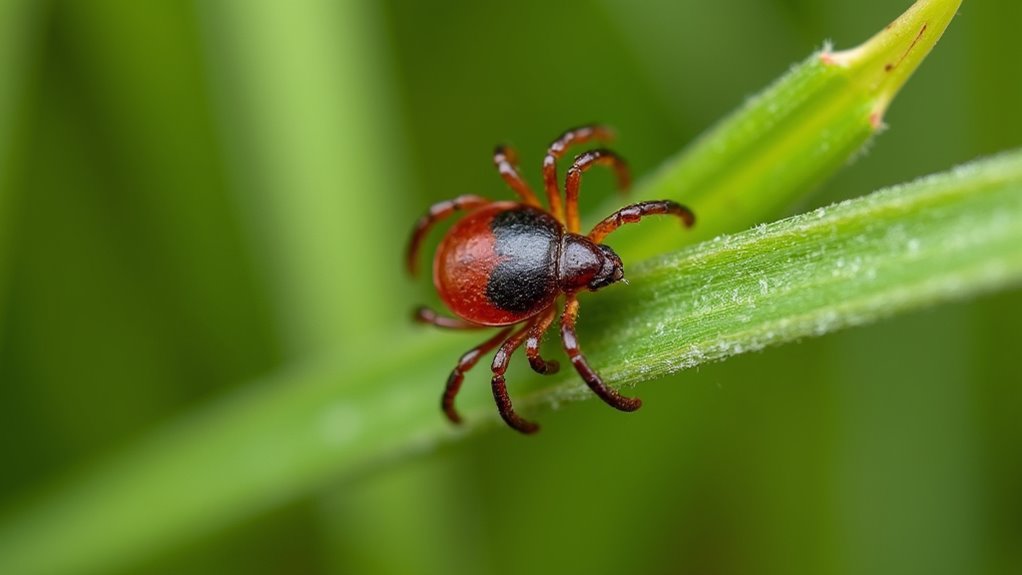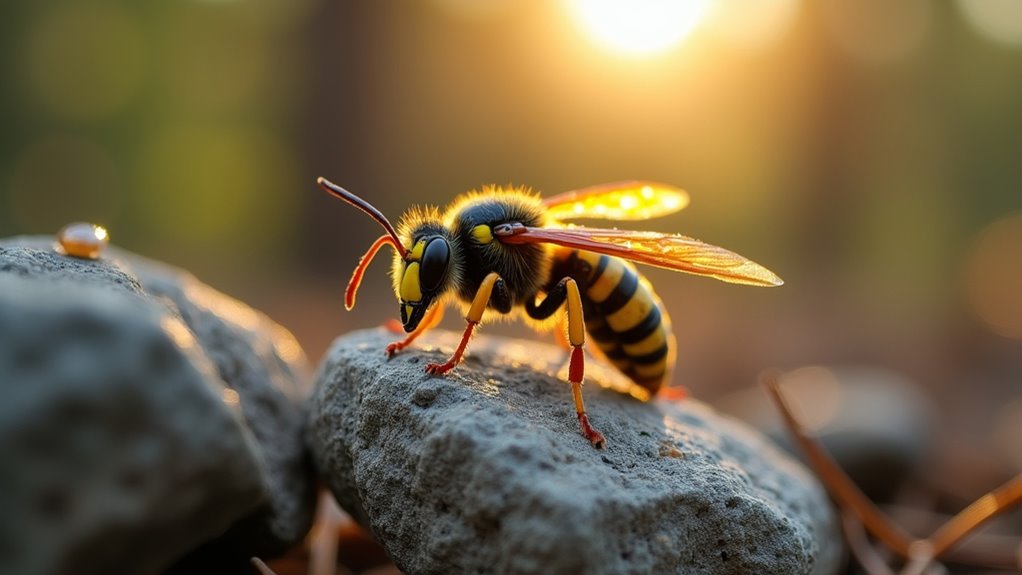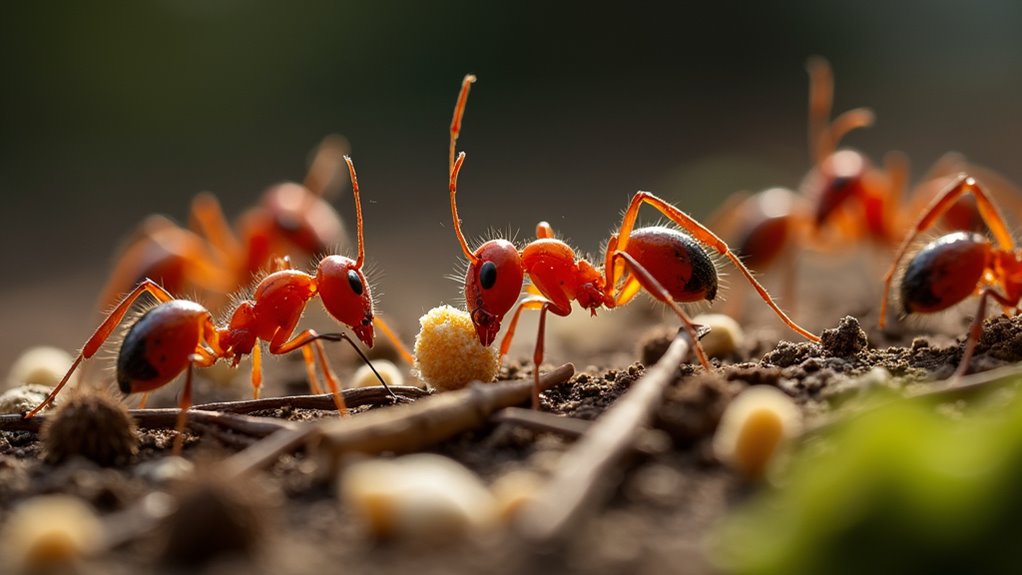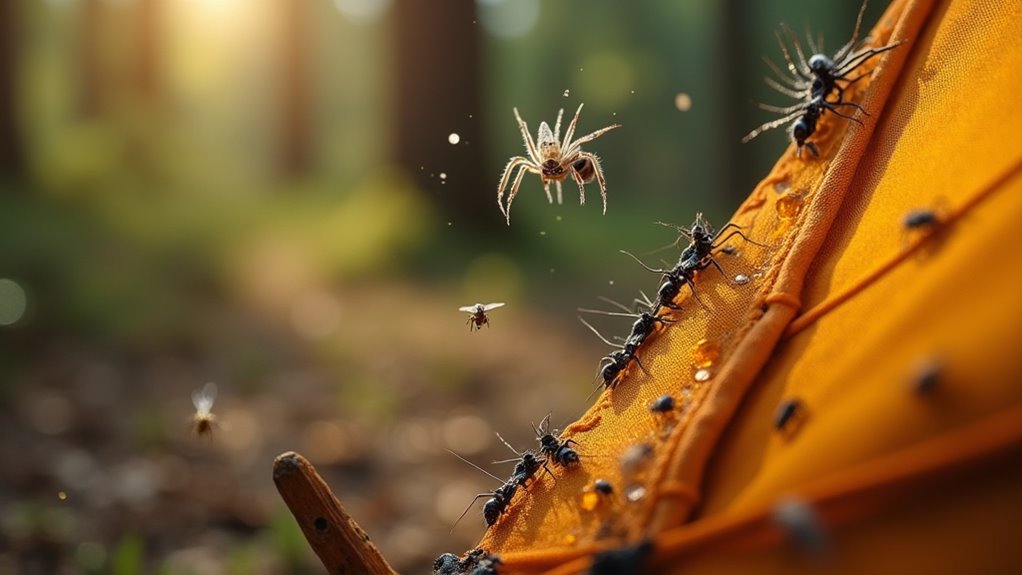Physical Address
304 North Cardinal St.
Dorchester Center, MA 02124
Physical Address
304 North Cardinal St.
Dorchester Center, MA 02124

Just when you think you've packed everything for camping, these tiny creatures can ruin your trip in ways you never imagined.
Did you know that a single mosquito can bite you up to 20 times in one night? When you’re planning your next camping adventure, you’ll encounter far more than just mosquitoes in the wilderness. From disease-carrying ticks lurking in tall grass to aggressive wasps defending their territory, the great outdoors hosts an army of tiny creatures that can quickly turn your peaceful getaway into an itchy, painful ordeal. Here’s what you need to watch for and how to protect yourself.

Where exactly are ticks lurking during your camping adventures? You’ll find them in tall grass, leaf litter, and brushy areas where they wait for hosts to pass by. They’re most active during warmer months, particularly in wooded regions.
Ticks hide in tall grass, leaf litter, and brushy areas, waiting patiently for unsuspecting campers to walk by during warmer months.
Check yourself regularly for ticks, especially around your hairline, behind ears, and in warm body creases. Wear long pants tucked into socks and use insect repellent containing DEET. Light-colored clothing helps you spot ticks more easily.
If you find an attached tick, remove it immediately using fine-tipped tweezers. Grasp close to the skin and pull straight up with steady pressure. Clean the bite area with alcohol afterward.
Watch for symptoms like fever, rash, or flu-like illness following tick exposure, as these could indicate Lyme disease or other tick-borne illnesses requiring medical attention. Consider treating your camping gear and clothing with permethrin-based products before your trip for additional protection against ticks.
While ticks pose a serious threat on the ground, mosquitoes and other flying bloodsuckers attack from above, turning peaceful camping evenings into itchy nightmares. You’ll encounter mosquitoes, black flies, no-see-ums, and horse flies depending on your location and season.
Pack DEET-based repellent with at least 20% concentration for effective protection. Permethrin-treated clothing creates an additional barrier. Set up camp away from standing water where mosquitoes breed. Choose breezy spots since these insects struggle in wind.
Wear long sleeves and pants during dawn and dusk when mosquitoes are most active. Light-colored clothing attracts fewer insects than dark colors. Consider portable fans around your campsite—they disrupt flight patterns while providing cooling relief.
Mosquito netting over sleeping areas ensures peaceful nights. Despite these challenges, Minnesota offers numerous exciting activities that make dealing with these insects worthwhile for outdoor enthusiasts.

Unlike mosquitoes that simply want your blood, stinging insects defend their territory aggressively and can ruin your camping trip with painful attacks.
You’ll encounter wasps, bees, and hornets near food sources, garbage, and flowering plants around your campsite.
Don’t swat at them or make sudden movements – you’ll trigger their defensive instincts. Instead, move slowly and calmly away from the area.
Keep food covered and dispose of trash properly, especially sugary drinks and fruit scraps that attract these insects.
If you’re allergic, carry an EpiPen and inform your camping companions about your condition.
For everyone else, pack antihistamines and ice packs to treat stings.
Choose campsites away from fallen fruit trees, flowering bushes, and standing water where these insects commonly nest and feed.
In areas where mosquitoes are particularly problematic, consider bringing mosquito nets to protect your sleeping area from these blood-seeking pests.
Spiders lurk in nearly every camping environment, from woodpiles and rocky crevices to your tent’s dark corners. While most spiders won’t harm you, venomous species like black widows and brown recluses require serious attention.
You’ll recognize black widows by their shiny black bodies and red hourglass markings, while brown recluses sport violin-shaped markings on their backs.
Stay protected by following these essential precautions:
If you’re bitten by a venomous spider, seek immediate medical attention. Don’t attempt home remedies—professional treatment’s your best bet for avoiding serious complications.
Pregnant campers should take extra precautions with spider safety, as venomous bites can pose additional risks during pregnancy.

Though they’re often overlooked until it’s too late, ants and other ground-dwelling insects can quickly turn your peaceful camping trip into an uncomfortable ordeal. Fire ants deliver painful, burning stings that create itchy welts lasting days. You’ll find them in sandy areas and disturbed soil throughout warmer regions.
Chiggers are nearly invisible mites that attach to your skin, causing intense itching for weeks. They lurk in tall grass and brushy areas. Ground beetles and earwigs don’t bite but can pinch when threatened.
Prevent encounters by checking your campsite for ant hills before setting up. Keep food sealed and elevated. Apply insect repellent to ankles and lower legs. Wear long pants when walking through vegetation, and always shake out clothing and shoes before putting them on. While these ground-dwelling pests can be troublesome, don’t forget that mosquito prevention strategies are equally important for a comfortable camping experience.
While ground-dwelling pests attack from below, flying insects assault you from every angle with their relentless buzzing and biting. Flies, mosquitoes, gnats, and other airborne nuisances can quickly turn your peaceful camping trip into a swatting marathon.
These persistent pests are most active during dawn and dusk when temperatures cool. They’re attracted to food, sweat, and carbon dioxide from your breath.
Here’s how to minimize their impact:
Don’t underestimate black flies and no-see-ums – they’re tiny but deliver painful bites. Screen tents and bug nets become your best friends when dealing with these aerial attackers. Creating a comprehensive strategy that combines multiple bug prevention methods will give you the best chance at enjoying a bite-free outdoor experience.

Since prevention beats treatment when battling camping pests, you’ll want to arm yourself with the right combination of repellents and protective gear before heading into the wilderness. DEET-based repellents offer reliable protection against mosquitoes, ticks, and flies, while picaridin provides a less greasy alternative that’s gentler on skin and gear. Don’t overlook permethrin-treated clothing, which creates a protective barrier that lasts through multiple washes.
Prevention trumps treatment when facing wilderness pests—equip yourself with DEET repellents, picaridin alternatives, and permethrin-treated clothing before venturing outdoors.
Pack a head net for heavily infested areas—it’s lightweight and invaluable when insects swarm.
Choose long-sleeved shirts and pants in light colors, as darker fabrics attract more bugs.
Set up camp away from standing water where mosquitoes breed, and consider a portable thermacell device for creating bug-free zones around your campsite during evening hours. Following these bug-free camping strategies will help ensure your outdoor adventure remains comfortable and enjoyable without the constant annoyance of biting insects.
Don’t let tiny troublemakers turn your outdoor adventure into a nightmare. You’ve got the knowledge now—use it as your shield against nature’s smallest warriors. Pack your repellents, choose your campsite wisely, and stay vigilant. Remember, it’s not the size of the pest that matters, but the havoc it can wreak. With proper preparation and awareness, you’ll keep these miniature menaces at bay and focus on what really matters: enjoying the great outdoors safely.